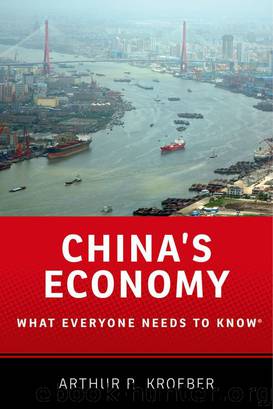China's Economy: What Everyone Needs to Know? by Arthur R. Kroeber

Author:Arthur R. Kroeber [Kroeber, Arthur R.]
Language: eng
Format: epub
ISBN: 9780190239039
Publisher: Oxford University Press
Published: 2016-03-01T05:00:00+00:00
What Is the Importance of the “One-Child Policy”?
As a population control measure, the significance of the “one-child policy” is far less than is generally believed. The major decline in China’s fertility rate occurred in the 1970s—before the “one-child policy” was adopted in 1980. During the 1980s enforcement of the new policy was chaotic and fluctuating: sometimes savage, with widespread reports of forced abortions and forced sterilizations; and sometimes relaxed, leading to surges of births in the countryside. By the late 1980s the policy was codified in a more pragmatic way, with a blanket exception for rural families (who were permitted to have a second child if their first was a girl) and more relaxed quotas for ethnic minorities. It might more accurately be called the “one-and-a-half-child policy,” since under perfect enforcement, only 60 percent of families would be limited to one child, and the fertility rate would be about 1.5.5 This policy remained in full effect for a quarter-century, until a slight easing in late 2013. In late 2015, policy was changed to allow all couples to have two children.
The impact of the policy is far from clear. In 1980 the fertility rate was 2.4; by 1990 it was around 2.1, which is the replacement level. By 2000 it was down to 1.4, and since then it has fluctuated between 1.4 and 1.5. It is impossible to know how much of this reduction came from the policy, and how much resulted from factors such as the migration of vast numbers of country dwellers to the city (migrant worker families have fewer children than families that stay on the farm). Other East Asian countries without similarly restrictive birth control policies have seen even more rapid reductions in their fertility rates, to about China’s level, in recent decades. In South Korea, fertility fell from 2.8 in 1980 to 1.6 in 1990 and reached 1.2 in 2010; in Thailand during the same 1980–2010 period, the rate fell from 3.4 to 1.4.6
It is hard to avoid the conclusion that the one-child policy was one of the worst major policies of the reform era. It was unnecessary when it was introduced; savage at times, and consistently intrusive and demeaning to the women who had to endure annual birth-control examinations even if they were not forced into abortions or sterilization; and far more long-lasting than it should have been. The main reason it endured is bureaucratic inertia: the State Family Planning Commission (SPFC) that enforced it has 500,000 employees and six million part-time workers, and it collects millions of dollars in fines every year. It had every incentive to keep the policy in place simply to protect all these jobs and revenues, and it did so by constantly overstating the fertility rate and claiming that its services were still urgently needed.7 Only after the 2010 census conclusively proved that the fertility rate was far lower than the SFPC had claimed, and after the SFPC was deprived of its separate status and put under the Ministry of Health, could the policy finally start relaxing.
Download
This site does not store any files on its server. We only index and link to content provided by other sites. Please contact the content providers to delete copyright contents if any and email us, we'll remove relevant links or contents immediately.
The Secret History by Donna Tartt(16627)
The Social Justice Warrior Handbook by Lisa De Pasquale(11489)
Thirteen Reasons Why by Jay Asher(7788)
This Is How You Lose Her by Junot Diaz(5775)
Weapons of Math Destruction by Cathy O'Neil(5038)
Zero to One by Peter Thiel(4824)
The Myth of the Strong Leader by Archie Brown(4789)
Promise Me, Dad by Joe Biden(4449)
Beartown by Fredrik Backman(4420)
Stone's Rules by Roger Stone(4417)
How Democracies Die by Steven Levitsky & Daniel Ziblatt(4399)
The Fire Next Time by James Baldwin(4343)
100 Deadly Skills by Clint Emerson(4079)
A Higher Loyalty: Truth, Lies, and Leadership by James Comey(4033)
Rise and Kill First by Ronen Bergman(4012)
The David Icke Guide to the Global Conspiracy (and how to end it) by David Icke(3883)
The Farm by Tom Rob Smith(3872)
Secrecy World by Jake Bernstein(3783)
The Doomsday Machine by Daniel Ellsberg(3732)
